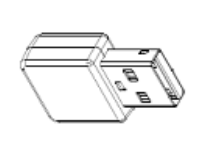Wistron NeWeb DNUA93F WLAN 802.11 b/g/n USB Adapter User Manual
Wistron NeWeb Corporation WLAN 802.11 b/g/n USB Adapter
User Manual

WLAN 802.11 b/g/n USB Adapter
DNUA-93F User Manual
October 2010
1
Copyright Statement
No part of this publication may be reproduced, stored in a retrieval system, or transmitted in any
form or by any means, whether electronic, mechanical, photocopying, recording or otherwise
without the prior writing of the publisher.
Pentium is trademark of Intel.
All copyright reserved.
2
FCC Statement
Federal Communication Commission Interference Statement
This equipment has been tested and found to comply with the limits for a Class B digital device,
pursuant to Part 15 of the FCC Rules. These limits are designed to provide reasonable protection
against harmful interference in a residential installation. This equipment generates, uses and can
radiate radio frequency energy and, if not installed and used in accordance with the instructions,
may cause harmful interference to radio communications. However, there is no guarantee that
interference will not occur in a particular installation. If this equipment does cause harmful
interference to radio or television reception, which can be determined by turning the equipment
off and on, the user is encouraged to try to correct the interference by one of the following
measures:
● Reorient or relocate the receiving antenna.
● Increase the separation between the equipment and receiver.
● Connect the equipment into an outlet on a circuit different from that to which the receiver
is connected.
● Consult the dealer or an experienced radio/TV technician for help.
FCC Caution: Any changes or modifications not expressly approved by the party responsible
for compliance could void the user’s authority to operate this equipment.
This device complies with Part 15 of the FCC Rules. Operation is subject to the following two
conditions: (1) This device may not cause harmful interference, and (2) this device must accept
any interference received, including interference that may cause undesired operation.
For product available in the USA/Canada market, only channel 1~11 can be operated. Selection of
other channels is not possible.
This device and its antenna(s) must not be co-located or operation in conjunction with any other
antenna or transmitter.
IMPORTANT NOTE:
FCC Radiation Exposure Statement:
This equipment complies with FCC radiation exposure limits set forth for an uncontrolled
environment. This equipment should be installed and operated with minimum distance 20cm
between the radiator & your body.
3
IC Statement
This Class B digital apparatus complies with Canadian ICES-003.
Operation is subject to the following two conditions: (1) this device may not cause interference,
and (2) this device must accept any interference, including interference that may cause undesired
operation of the device.
Cet appareil numérique de la classe B est conforme á la norme NMB-003 du Canada.
For product available in the USA/Canada market, only channel 1~11 can be operated. Selection of
other channels is not possible.
This device and its antenna(s) must not be co-located or operation in conjunction with any other
antenna or transmitter.
IMPORTANT NOTE:
IC Radiation Exposure Statement:
This equipment complies with IC RSS-102 radiation exposure limits set forth for an uncontrolled
environment. This equipment should be installed and operated with minimum distance 20cm
between the radiator & your body.

4
Table of Contents
1. INTRODUCTION 5
2. DRIVER/UTILITY INSTALLATION / UNINSTALLATION 5
3. CONNECTING TO AN EXISTING NETWORK 5
4. MODIFYING A WIRELESS NETWORK 6
4.1 MODIFYING GENERAL SETTINGS .............................................................................................. 6
4.2 MODIFYING SECURITY SETTINGS.............................................................................................. 7
5. SPECIFICATIONS 9
APPENDIX A: FAQ ABOUT WLAN 10
5
1. Introduction
Thank you for purchasing the WLAN 802.11 b/g/n USB Adapter that provides the easiest way to
wireless networking. This User Manual contains detailed instructions in the operation of this
product. Please keep this manual for future reference.
System Requirements
- 128 MB of RAM or later (recommended)
- 300 MHz processor or higher
2. Driver/Utility Installation
The driver should have been installed before the TV is shipped from the manufacturer. You can
plug this adapter to your TV and start using its network function without installing driver or
utility.
3. Connecting to an Existing Network
1. Use the remote control that came with your TV to access the network configuration settings
page.
2. Select the scanning wireless network function. The system starts to scan for available network.
On this list, click Refresh to refresh the list at any time
3. Select the network you want to connect to.
4. If the chosen network has security enabled, you will have to setup corresponding security
parameter. Contact the network manager for the correct settings. Select the security type and
fill in required parameters. The options include the following:
• WPA/WPA2/CCKM
• WPA/WPA2 Passphrase
• 802.1x
• Pre-Shared Key (Static WEP)
• None

6
4. Modifying a Wireless Network
4.1 Modifying General Settings
1. Use the remote control that came with your TV to access the network configuration settings
page.
2. From the profile list, select one profile and choose the modify function.
3. Modify the settings below for your network.
Profile Name Identifies the configuration wireless network profile.
This name must be unique. Profile names are not case
sensitive.
Client Name Identifies the client machine.
Use this profile for
Access Point mode
Configures station to operate in Access Point mode.
Network Names (SSIDs) The IEEE 802.11 wireless network name. This field has
a maximum limit of 32 characters. Configure up to three
SSIDs (SSID1, SSID2, and SSID3).

7
4.2 Modifying Security Settings
1. Use the remote control that came with your TV to access the network configuration settings
page.
2. Select a security option of this wireless network. This product provides security options below.
Contact your wireless network administrator for choosing a correct option.
• WPA/WPA2/CCKM
• WPA/WPA2 Passphrase
• 802.1x
• Pre-Shared Key (Static WEP)
• None
WPA/WPA2 Enables the use of Wi-Fi Protected Access (WPA).
Choosing WPA/WPA2 opens the WPA/WPA2 EAP drop-down menu.
The options include:
EAP-FAST
EAP-TLS
EAP-TTLS
EAP-SIM
PEAP (EAP-GTC)
PEAP (EAP-MSCHAP V2)
LEAP
WPA/WPA2
Passphrase Enables WPA/WPA2 Passphrase security.
Click on the Configure button and fill in the WPA/WPA2 Passphrase.
802.1x Enables 802.1x security. This option requires IT administration.
Choosing 802.1x opens the 802.1x EAP type drop-down menu. The
options include:
EAP-FAST
EAP-TLS
EAP-TTLS
EAP-SIM
PEAP (EAP-GTC)
PEAP (EAP-MSCHAP V2)
LEAP
Pre-Shared Key
(Static WEP) Enables the use of pre-shared keys that are defined on both the access
point and the station.
To define pre-shared encryption keys, choose the Pre-Shared Key radio
button and click the Configure button to fill in the Define Pre-Shared
Keys window.

8
None No security (not recommended).
Allow Association to
Mixed Cells Check this check box if the access point with which the client adapter is
to associate has WEP set to Optional and WEP is enabled on the client
adapter. Otherwise, the client is unable to establish a connection with
the access point.
Limit Time for
Finding Domain
Controller To
Check this check box and enter the number of seconds (up to 300) after
which the authentication process times out when trying to find the
domain controller. Entering zero is like unchecking this check box,
which means no time limit is imposed for finding the domain controller.
Note: The authentication process times out whenever the authentication
timer times out or the time for finding the domain controller is reached.
Group Policy Delay Specify how much time elapses before the Windows logon process
starts group policy. Group policy is a Windows feature used by
administrators to specify configuration options for groups of users. The
objective is to delay the start of Group Policy until wireless network
authentication occurs. Valid ranges are from 0 to 65535 seconds. The
value that you set goes into effect after you reboot your computer with
this profile set as the active profile.
This drop-down menu is active only if you chose EAP-based
authentication.
9
5. Specifications
Dimensions: 30(L) * 17(W) * 8.5(H) mm
Frequency range: USA: 2.400 ~ 2.483GHz,
Europe: 2.400 ~ 2.483GHz,
Japan: 2.400 ~ 2.497GHz,
China: 2.400 ~ 2.483GHz,
Channels support: 802.11n b/g
US/Canada: 11 (1 ~ 11)
Major European country: 13 (1 ~ 13)
France: 4 (10 ~ 13)
Japan: 11b: 14 (1~13 or 14th), 11g: 13 (1 ~ 13)
China: 13 (1 ~ 13)
Operation temperature
Host interface: USB 2.0
Operation temperature: 0
o ~ 40o C
Storage temperature: -10o ~ 70o C
10
Appendix A: FAQ about WLAN
1. What is Spread Spectrum?
Spread Spectrum technology is a wideband radio frequency technique developed by the military
for use in reliable, secure, mission-critical communications systems. It is designed to trade off
bandwidth efficiency for reliability, integrity, and security. In other words, more bandwidth is
consumed than in the case of narrowband transmission, but the trade-off produces a signal that is,
in effect, louder and thus easier to detect, provided that the receiver knows the parameters of the
spread-spectrum signal being broadcast. If a receiver is not tuned to the right frequency, a
spread-spectrum signal looks like background noise. There are two main alternatives, Direct
Sequence Spread Spectrum (DSSS) and Frequency Hopping Spread Spectrum (FHSS).
2. What is DSSS? What is FHSS? And what are their differences?
Frequency-Hopping Spread-Spectrum (FHSS) uses a narrowband carrier that changes frequency
in a pattern that is known to both transmitter and receiver. Properly synchronized, the net effect is
to maintain a single logical channel. To an unintended receiver, FHSS appears to be
short-duration impulse noise. Direct-Sequence Spread-Spectrum (DSSS) generates a redundant
bit pattern for each bit to be transmitted. This bit pattern is called a chip (or chipping code). The
longer the chip, the greater the probability that the original data can be recovered. Even if one or
more bits in the chip are damaged during transmission, statistical techniques embedded in the
radio can recover the original data without the need for retransmission. To an unintended receiver,
DSSS appears as low power wideband noise and is rejected (ignored) by most narrowband
receivers.
3. Would the information be intercepted while transmitting on air?
WLAN features two-fold protection in security. On the hardware side, as with Direct Sequence
Spread Spectrum technology, it has the inherent security feature of scrambling. On the software
side, WLAN offers the encryption function (WEP) to enhance security and access control.
4. What is WEP?
WEP is Wired Equivalent Privacy, a data privacy mechanism based on a 64-bit or 128-bit shared
key algorithm, as described in the IEEE 802.11 standard.
5. What is infrastructure mode?
When a wireless network is set to infrastructure mode, the wireless network is configured to
communicate with a wired network through a wireless access point.
11
6. What is roaming?
Roaming is the ability of a portable computer user to communicate continuously while moving
freely throughout an area greater than that covered by a single access point. Before using the
roaming function, the workstation must make sure that it is the same channel number with the
access point of dedicated coverage area.
To achieve true seamless connectivity, the wireless LAN must incorporate a number of different
functions. Each node and access point, for example, must always acknowledge receipt of each
message. Each node must maintain contact with the wireless network even when not actually
transmitting data. Achieving these functions simultaneously requires a dynamic RF networking
technology that links access points and nodes. In such a system, the user’s end node undertakes a
search for the best possible access to the system. First, it evaluates such factors as signal strength
and quality, as well as the message load currently being carried by each access point and the
distance of each access point to the wired backbone. Based on that information, the node next
selects the right access point and registers its address. Communications between end node and
host computer can then be transmitted up and down the backbone. As the user moves on, the end
node’s RF transmitter regularly checks the system to determine whether it is in touch with the
original access point or whether it should seek a new one. When a node no longer receives
acknowledgment from its original access point, it undertakes a new search. Upon finding a new
access point, it then re-registers, and the communication process continues.